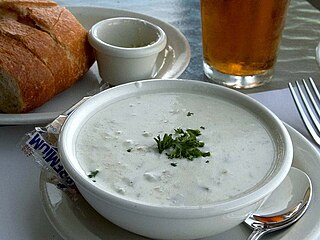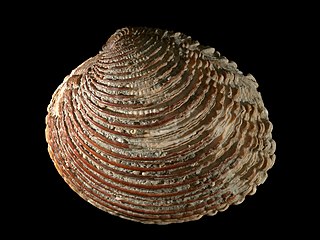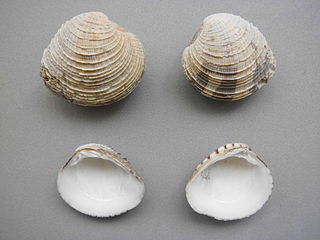
Clam is a common name for several kinds of bivalve molluscs. The word is often applied only to those that are edible and live as infauna, spending most of their lives halfway buried in the sand of the seafloor. Clams have two shells of equal size connected by two adductor muscles and have a powerful burrowing foot. Clams in the culinary sense do not live attached to a substrate and do not live near the bottom. In culinary usage, clams are commonly eaten marine bivalves, as in clam digging and the resulting soup, clam chowder. Many edible clams such as palourde clams are oval or triangular; however, razor clams have an elongated parallel-sided shell, suggesting an old-fashioned straight razor.

Wampum is a traditional shell bead of the Eastern Woodlands tribes of American Indians. It includes white shell beads hand fashioned from the North Atlantic channeled whelk shell and white and purple beads made from the quahog or Western North Atlantic hard-shelled clam. Before European contact, strings of wampum were used for storytelling, ceremonial gifts, and recording important treaties and historical events, such as the Two Row Wampum Treaty or The Hiawatha Belt. Wampum was also used by the northeastern Indian tribes as a means of exchange, strung together in lengths for convenience. The first Colonists adopted it as a currency in trading with them. Eventually, the Colonists applied their technologies to more efficiently produce wampum, which caused inflation and ultimately its obsolescence as currency.

Southampton Water is a tidal estuary north of the Solent and the Isle of Wight in England. The city of Southampton lies at its most northerly point. Along its salt marsh-fringed western shores lie the New Forest villages of Hythe and "the waterside", Dibden Bay, and the Esso oil refinery at Fawley. On the slightly steeper eastern shore are the Southampton suburb of Weston, the villages of Netley and Hamble-le-Rice, and the Royal Victoria Country Park.

Clam chowder is any of several chowder soups containing clams and broth. In addition to clams, common ingredients include diced potatoes, onions, and celery. Other vegetables are not typically used, but small carrot strips or a garnish of parsley might occasionally be added primarily for color. A garnish of bay leaves adds both color and flavor. It is believed that clams were used in chowder because of the relative ease of harvesting them. Clam chowder is usually served with saltine crackers or small, hexagonal oyster crackers.

The clambake or clam bake, also known as the New England clambake is a traditional method of cooking seafood, such as lobster, mussels, crabs, soft-shell clams, and quahogs. The food is traditionally cooked by steaming the ingredients over layers of seaweed. The shellfish can be supplemented with vegetables, such as onions, carrots, and corn on the cob. Clambakes are usually held on festive occasions along the coast of New England.

Clam digging is a North American term for a common way to harvest clams from below the surface of the tidal sand flats or mud flats where they live. It is done both recreationally and commercially. Commercial digging in the U.S. and Canada is colloquially referred to as clamming, and is done by a clammer.
Shell money is a medium of exchange similar to coin money and other forms of commodity money, and was once commonly used in many parts of the world. Shell money usually consisted of whole or partial sea shells, often worked into beads or otherwise shaped. The use of shells in trade began as direct commodity exchange, the shells having value as body ornamentation. The distinction between beads as commodities and beads as money has been the subject of debate among economic anthropologists.

FMRFamide (H-Phe-Met-Arg-Phe-NH2) is a neuropeptide from a broad family of FMRFamide-related peptides (FaRPs) all sharing an -RFamide sequence at their C-terminus. First identified in Hard clam, it is thought to play an important role in cardiac activity regulation. Several FMRFamied related peptides are known, regulating various cellular functions and possessing pharmacological actions, such as anti-opiate effects. In Mercenaria mercenaria, FMRFamide has been isolated and demonstrated to increase both the force and frequency of the heartbeat through a biochemical pathway that is thought to involve the increase of cytoplasmic cAMP in the ventricular region.
Clam cakes are a New England food, most commonly found in Rhode Island although they can also be found in Connecticut, Maine, and Massachusetts. Each clam cake is a deep fried ball-shaped mixture containing chopped clam combined with various other ingredients to give it a firm consistency once fried. The batter is made from flour, milk, clam juice, eggs and a leavening agent, typically baking powder. Hank Shaw once described it as, "think clam beignet, or donut hole. Only savory. Crispy, golden brown on the outside, pillowy and light on the inside. Steam rises from the first bite. The slightest aroma of brine surrounds you. Tiny chunks of clam nestle themselves in the folds of the pillow, offering surprising bites of chewy meatiness as you down one of these little glories after another."

The Veneridae or venerids, common name: venus clams, are a very large family of minute to large, saltwater clams, marine bivalve molluscs. Over 500 living species of venerid bivalves are known, most of which are edible, and many of which are exploited as food sources.

Mercenaria is a genus of edible saltwater clams, marine bivalve molluscs in the family Veneridae, the Venus clams.

Chione cancellata, is a species of medium-sized saltwater clam, a marine bivalve mollusc in the family Veneridae, the venus clams.

Stuffed clams are popular in New England, especially in Rhode Island, and consist of a breadcrumb and minced clam mixture that is baked on the half shell of a quahog hard shell clam. Other ingredients typically found in the basic breadcrumb mixture are: meat such as sausage, bacon or chouriço, chili pepper, lemon juice, bell peppers, celery, onion, garlic, spices and herbs. There are many different recipes for stuffed clams; many restaurants in New England have their own variety, as do many home cooks.
M. mercenaria may refer to:
The Maine accent is the local traditional dialect of Eastern New England English native to parts of Maine, especially along the "Down East" and "Mid Coast" seaside regions. It is characterized by a variety of features, particularly among older speakers, including r-dropping (non-rhoticity), resistance to the horse–hoarse merger, a deletion or "breaking" of certain syllables, and some unique vocabulary. This traditional Maine accent is rapidly declining; a 2013 study of Portland speakers found the horse–hoarse merger to be currently embraced by all ages and the cot–caught merger to be resisted, despite being typical among other Eastern New England speakers, even reported in the 1990s in Portland itself. In the northern region of Maine along the Quebec border, Franco-Americans may show French-language influences in their English.

The quahog parasite unknown, or QPX, is a single-celled protist parasite in the class Labyrinthulomycota. It affects hard clams, or quahogs, both cultured and wild.
Southampton Power Station was a coal fired power station built by Southampton corporation that operated between 1904 and 1977.












